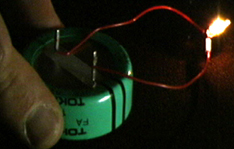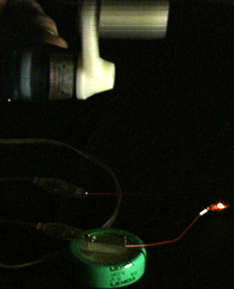|
Direct Current
|
|
|
| Seat Experiment |
 |
Using a supercapacitor, some wire, a Genecon and a light bulb we will explore the charging and discharging of a capacitor. |
|
First test the Genecon without a load. Does it turn easily? Clip the leads together and turn the handle. This represents a full load on the Genecon. What happens? Connect the generator to the light bulb as shown. Turn the Genecon handle steadily and slowly. Q1: Describe and discuss these effects in terms of work, energy and light. |
 |
 |
Connect the bulb in parallel with the capacitor and Genecon. Charge the capacitor and remove the Genecon. What happens? Q2: Describe
how lamp brightness changes with time.
|
|
Now connect just the Genecon and the capacitor in parallel. Charge the capacitor and leave the Genecon attached. What happens? What causes this effect? Q4: How does the discharge of a capacitor compare to that of a battery? Q5: Why does the Genecon become a motor in part 3? Q6: Draw a circuit diagram for each operation above. |
 |
| Q7:
Try to determine what direction current would flow in the circuits
you just drew.
Q8: What would happen if you left the Genecon and bulb in parallel to the capacitor after you charged the capacitor. Try it. Describe and discuss the results and your prediction. |
| References |
| Chabay & Sherwood, Electric and Magnetic Interactions,
Carnegie Melon University Priscilla W. Laws, Workshop Physics, Dickinson College |
|
|
|
|